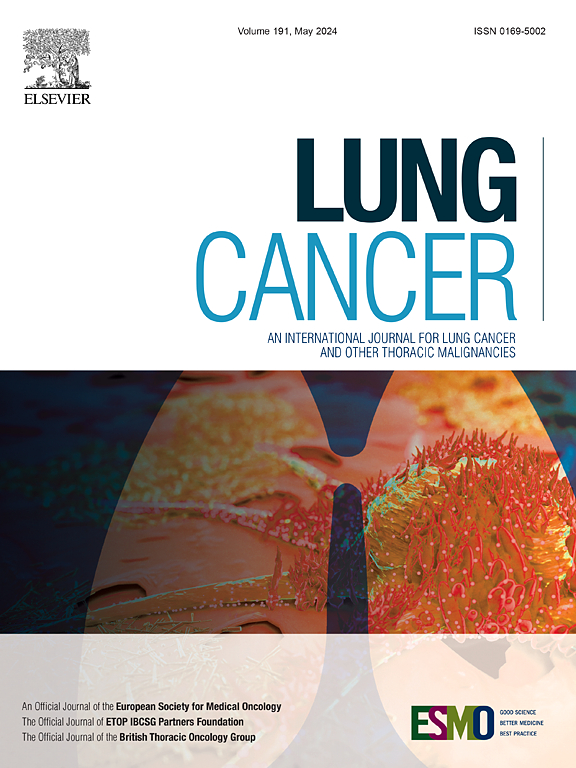Advanced-stage ALK-positive non–small-cell lung cancer (NSCLC) patients: Real-world treatment patterns and outcomes from the Italian biomarker ATLAS database
IF 4.4
2区 医学
Q1 ONCOLOGY
引用次数: 0
Abstract
Background
Treatment of advanced ALK + NSCLC has improved with increasingly effective ALK tyrosine-kinase inhibitors (TKIs). We report real-world treatment patterns and outcomes from the Italian ATLAS registry.
Methods
Clinical-pathological and treatment data were retrospectively and prospectively collected from 37 Italian centers.
Results
463 ALK + advanced NSCLC patients treated from 2019 to 2024 were included. 431 (93 %) patients received 1st line (1L) ALK TKIs, mostly alectinib (82.5 %). 1L treatment choice, reported in 142 cases, was driven by drug access as first (31 %) or subsequent lines (40.1 %) and by safety (21.8 %). Among 382 patients receiving 1L alectinib overall survival (OS) rate was 88.7 % and 73.3 % at 24 and 60 months, respectively. Median progression-free survival (mPFS) was 43.1 months (95 %CI: 29.5–57.0). Brain was a new site of progression in 11 (3.6 %) patients. Intracranial PFS rate was 73.1 % and 59.1 % at 24 and 36 months with a 64.7 % intracranial response rate. Grade ≥ 3 adverse events occurred in 41 (10.7 %) patients, mainly hepatic toxicity (13, 3.4 %) and asthenia (5, 1.3 %). At progression tissue and/or liquid biopsy were performed in 28 (23.5 %) and 20 (16.8 %) cases, respectively. Out of 80 patients receiving 2nd line therapy after alectinib, 67 (83.8 %) received lorlatinib achieving mPFS 7.5 (95 % CI: 6.2–8.8) and mOS 26.4 months (95 % CI: 19.1–33.7). 17 (15.5 %) patients died without second line therapy.
Conclusions
Real-world data confirm the effectiveness and safety of alectinib, used as preferred upfront ALK-TKI. The recent 1L lorlatinib approval might change this scenario. Tissue/liquid biopsy at disease progression are underperformed in clinical practice.
晚期alk阳性非小细胞肺癌(NSCLC)患者:来自意大利生物标志物ATLAS数据库的现实世界治疗模式和结果
随着ALK酪氨酸激酶抑制剂(TKIs)的日益有效,晚期ALK + NSCLC的治疗得到了改善。我们报告来自意大利ATLAS注册的真实世界的治疗模式和结果。方法回顾性和前瞻性收集意大利37个中心的临床病理和治疗资料。结果纳入2019 - 2024年接受治疗的463例ALK +晚期NSCLC患者。431例(93%)患者接受一线(1L) ALK TKIs治疗,主要是阿勒替尼(82.5%)。据报告,在142例病例中,l治疗选择是由药物可及性(31%)或后续治疗(40.1%)和安全性(21.8%)驱动的。在382例接受1L alectiinib治疗的患者中,24个月和60个月的总生存率(OS)分别为88.7%和73.3%。中位无进展生存期(mPFS)为43.1个月(95% CI: 29.5-57.0)。11例(3.6%)患者的脑部为新进展部位。24个月和36个月的颅内PFS率分别为73.1%和59.1%,颅内缓解率为64.7%。41例(10.7%)患者发生≥3级不良事件,主要为肝毒性(13,3.4%)和虚弱(5,1.3%)。在进展中分别有28例(23.5%)和20例(16.8%)进行了组织和/或液体活检。在80名接受阿勒替尼后二线治疗的患者中,67名(83.8%)接受氯拉替尼治疗,mPFS为7.5 (95% CI: 6.2-8.8), mOS为26.4个月(95% CI: 19.1-33.7)。17例(15.5%)患者未接受二线治疗死亡。结论实际数据证实了alectinib作为首选的前期ALK-TKI的有效性和安全性。最近lorlatinib的批准可能会改变这种情况。在临床实践中,组织/液体活检在疾病进展中的应用不足。
本文章由计算机程序翻译,如有差异,请以英文原文为准。
求助全文
约1分钟内获得全文
求助全文
来源期刊

Lung Cancer
医学-呼吸系统
CiteScore
9.40
自引率
3.80%
发文量
407
审稿时长
25 days
期刊介绍:
Lung Cancer is an international publication covering the clinical, translational and basic science of malignancies of the lung and chest region.Original research articles, early reports, review articles, editorials and correspondence covering the prevention, epidemiology and etiology, basic biology, pathology, clinical assessment, surgery, chemotherapy, radiotherapy, combined treatment modalities, other treatment modalities and outcomes of lung cancer are welcome.
 求助内容:
求助内容: 应助结果提醒方式:
应助结果提醒方式:


